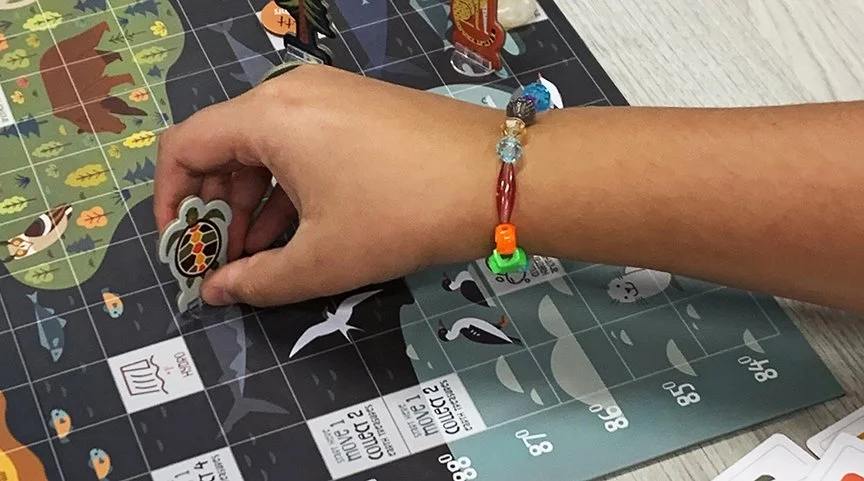Earth Matters Brings Game-Based Learning to This In-Depth Teaching Unit
Rachel Arbor, an educator and founder of Gaia Scholastic, has created an interdisciplinary teaching unit that combines in-depth research on Leatherback Sea Turtles with game-based learning, using Earth Matters as the catalyst.
“If our role as educators is to prepare students for the real world, shouldn’t we be supporting them in solving the climate crisis? By incorporating Earth Matters into the classroom, educators can help students gain a deeper understanding of climate change, environmental justice, and the systemic nature of global challenges,” says Rachel.
Interdisciplinary thinking that’s reflective of the real world.
Ideal for fourth- to sixth-grade students, this teaching unit provides students with the opportunity to confront real-world climate challenges and scenarios. Through this Unit, students (ideally 5th-graders) can track a day in the life of a Leatherback Turtle, exploring its biology, as well as the variables that impact its survival. Examining these influences helps students understand the interconnectedness of nature and how human behavior affects both individual species and entire ecosystems.
Rooted in Common Core ELA, Social Studies, and NGSS Science standards, the Unit is easily integrated into any of these content areas within five class periods. Students begin by exploring the biology and ecology of the Leatherback.
Once students have a foundational understanding of Leatherbacks, they work in small groups and choose specific "influencers" to research. This student choice promotes autonomy and engagement while ensuring every voice in the group is valued, as each offers a unique perspective.
Every topic contains a list of vetted, age-appropriate research resources and guiding information to support student success:
● Plastic Pollution: Where is plastic pollution an issue and why? What role does plastic pollution play in Leatherback survival, and how does it affect larger marine ecosystems?
● Moon Jellyfish: What’s the relationship between Moon Jellyfish and Leatherbacks? How is climate change affecting that relationship?
● Poachers: What is poaching, and where does it take place? What impact does poaching have on Leatherbacks, and what efforts are being made to reduce illegal harvesting?
● Fisheries: How do commercial fishing practices impact Leatherbacks through bycatch? How does the Endangered Species Act affect Fisheries and Leatherbacks alike?
● Tiger Sharks: Why are Tiger Sharks a Keystone predator, and what’s their relationship with Leatherbacks? How does plastic pollution affect Tiger Sharks?
Students divide the labor, become experts in their topic, and take ownership of their learning. The varied research topics encourage students to recognize how seemingly unrelated variables (like the presence of plastic or the legislation behind Fisheries) in the oceans are intricately connected.
Following their research, each student presents their findings to the group, helping educate their peers on the broader picture of Leatherback survival and its ecosystem through their unique perspectives. Students translate their shared research into the creation of a news report on the Leatherback, coined the “Leatherback Daily.” Together, their teamwork ensures the news report holistically and realistically represents the Leatherback’s daily life.
The Leatherback Unit offers students a unique perspective on the challenges faced by a specific species while also introducing them to broader environmental themes, including conservation, sustainability, and climate justice.
The Leatherback Unit Focuses on one of the Earth Matters Player Species
As the final deep dive, students play the interdisciplinary board game, Earth Matters. Players engage with knowledge across various subjects, including science, history, government, and societal practices. Each turn invites the player to make decisions that impact not just their immediate environment but also broader societal systems, encouraging empathy and exploration of how their actions can have far-reaching consequences. The game is a tool that supports students in understanding the interconnectedness of the world and employs critical thinking.
Environmentally-Literate Global Citizens of The Future
The Earth Matters board game and the Leatherback Unit together represent a powerful approach to environmental education: one that is comprehensive, accessible, and fun.
After teaching the unit, Rachel had this to say, “Having implemented this project in a 5th-grade classroom myself, I can say with confidence that students are hungry for this learning experience and eager to turn their climate anxiety into climate action.” Check out the complete unit here. You’ll find printable materials and video links for student research.




